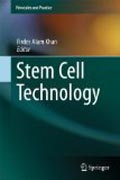
This book examines all topics essential to stem cell biology, stem cell research and stem cell technology, enabling readers to understand the basic, scientific, ethical, clinical and industrial aspects of stem cells in highly conciseand lucid terms. One reason that stem cells are important is the human development from stem cells. As such, an understanding of their unique attributes and control can teach us more about early human development. Diseases such as cancer are thought to result from abnormal cell proliferation and differentiation. This means that an understanding of where things go 'wrong' in stem cell division and thus lead to cancer can help us find ways to prevent these dysfunctional changes or treat them effectively using targeted drugs. Stem cell research has the potential to teach us more about how birth defects occur and how they can be prevented or possibly reversed. An understanding of the regulation and chemical triggers of stem cell proliferation and differentiation is key toaddressing birth defects. Likely the most important therapeutic value of stemcells is the use of cell therapies. A cell therapy is a treatment that replaces dysfunctional or diseased tissues with stem cells. At present, stem cells are already used in cell therapies for the treatment of some types of cancer, but this is only a small step given the number of diseases affecting humans today. Stem cells’ potential to replace damaged cells and tissues is an excitingpossibility for those who will require a transplant during their lifetime. Diseases that are expected to be treated with stem cells one day include Alzheimer’s and Parkinson’s diseases, as well as those diseases affecting the retina and the heart. In addition to cell therapy, the stem cells can also be used totest new drug molecules for their efficacy and toxicity, as it has been shownthat stem cells provide a better tool for studying the effects of new drug molecules on different types of cells such as neuronal cells, pancreatic cells or kidney cells that are derived from stem cells. Clearly, stem cell use is vital and holds great promise for treating and perhaps one day curing many diseases. First book, which deals with all the aspects of stem cell technology from bench to patients. Suitable not only for graduate students, but for everyone else, who works in a biotech lab. Combines theoretical background with methods and applications. INDICE: Introduction to Stem Cells. Characteristics of Stem Cells. Adult Stem Cells. Umbilical Cord Stem Cells. Embryonic Stem Cells. Induced Pluripotent Stem Cells. Stem Cells Culture. Characterization of Stem Cells. Signaling Mechanisms in Stem Cells. Genetic Manipulation of Stem Cells. Applications of Stem Cells. Stem Cell Lines and Stem Cell Banks. Production of Stem Cells. Stem Cell Therapy and Clinical Trials. Commercialization of Stem Cell Technology. Stem Cell Research and Funding. Intellectual Property Rights in Stem Cell Technology. Bioethical and Legal Aspects of Stem Cell Research. Stem Cell Technology: New Trends. Career Opportunities in Stem Cell Technology.
- ISBN: 978-3-642-23420-0
- Editorial: Springer Berlin Heidelberg
- Encuadernacion: Cartoné
- Páginas: 365
- Fecha Publicación: 31/12/2011
- Nº Volúmenes: 1
- Idioma: Inglés
